
The Helix bridge in Singapore. It's even got the letters G, A, T, and C light up at night. I worry what might happen if it starts replicating itself. That's a good premise for a disaster movie IMO.
Source: Wikimedia Commons contributors
Introduction
The most famous scientific paper of the last century, published in the journal Nature, is only one page long. Yes, it's shorter than this post. And, arguably, more important. And although it's written using all 26 letters of the English alphabet, it concerns itself mainly with only 4 of them: G, A, T, and C. For those of you who aren't geneticists, that's guanine, adenine, thymine, and cytosine. Or what I like to call, for mnemonic purposes, The Great GATC-by.
If you haven't already figured it out, the paper I'm referring to is Watson and Crick's "Molecular Structure of Nucleic Acids: A Structure for Deoxyribose Nucleic Acid", in which they reveal — pausing for suspense — the structure of DNA! (I bet you never saw that coming.) This post is about exploring this discovery, and some of the controversies that surround it, as well as a brief mention on the benefits open access might give to the speed with which scientific discoveries are made.
What was already known
It was already known, at the time Watson and Crick were trying to figure out the structure of DNA, that DNA was composed of subunits called nucleotides, and that these in turn were composed of a sugar (deoxyribose in DNA, ribose in RNA), a phosphate group, and a nitrogenous base that can be either adenine (A), thymine (T), guanine (G) or cytosine (C). That's the order in which these are customarily written, by the way, so my GATC-by mnemonic is a rearrangement, but it's useful if you want to remember that the G and A are the purine bases and T and C are the pyrimidine bases. (Who wouldn't want to remember that?)
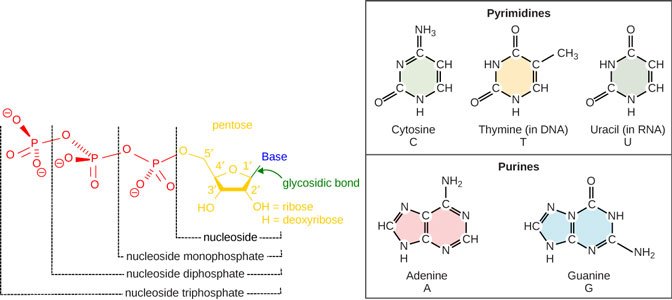
Source: OpenStax Biology
Another thing that was known at the time was Chargaff's rule. Chargaff was a biochemist who discovered, among other things, that the amounts of adenine are equal to the amounts of thymine, and the amounts of guanine are equal to the amounts of cytosine. More algebraically, Chargaff's rule looks like this: A=T and G=C. In philosophical formal logic we sometimes use the triple bar to represent equality, like so: G≡C. The importance of Chargaff's rule for Watson and Crick's discovery is made rather evident from the following image of a piece of a double stranded DNA molecule after the structure was discovered.
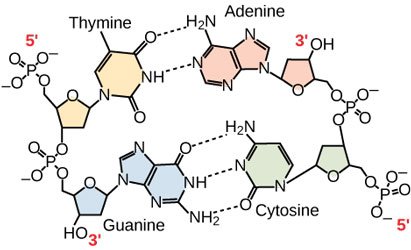
Two hydrogen bonds between A and T (A=T) and three between G and C (G≡C).
Source: OpenStax Biology
In other words, Watson and Crick knew that whatever structure they came up with should explain these equivalencies that Chargaff discovered between the nitrogenous bases.
A few other things that were known at the time, and without which Watson and Crick's discovery would probably have been impossible, deserve their own section.
To which we now move.
Ploddingly. Take your time.
Photograph 51: What was Franklin Rosalind hiding?
(Hey, I don't see why conspiracy theorists should always get the fancy titles, like "Area 51: What was Franklin D. Roosevelt hiding?")
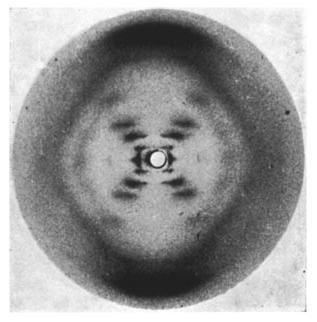
Rosalind Franklin's Photograph 51. Apparently, quite the clue to the double helical structure of DNA, if you paid any attention during your high-school X-ray crystallography classes. To me it looks like a vinyl record spinning real fast. Or the patch the X-Men wear on their superhero suits.
Source: Wikimedia Commons contributors
Watson and Crick were not alone in trying to discover the structure or DNA. In fact, they were racing against the best structural chemist of the time, and possibly of all time: Linus Pauling!
This is the guy, you will recall, who discovered the secondary structure of proteins because he was in bed with the flu and was looking for a way to kill time, so he got out some sheets of paper and started cutting them into shapes.
So it's understandable that Watson and Crick were very impatient in interpreting the latest then-current science had to offer, including the work of master X-ray crystallographer Rosalind Franklin. That eagerness of Watson and Crick didn't sit well with feet-on-the-ground hard-data scientist Rosalind Franklin, which led to conflicts.[6] For example, as soon as Watson saw Franklin's photograph 51, he cried "helix!" But she'd have none of that. In fact, she even went so far as to write a mock-obituary of the helix model, which you can read here. She would eventually come to accept the helical model, but only after the data warranted it.
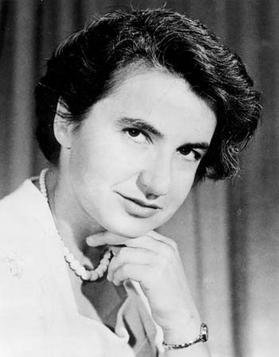
Hard-nosed scientist Rosalind Franklin.
Source: Wikimedia Commons contributors
The controversy is further compounded when you learn that photograph 51 was shown to Watson without Rosalind's knowledge or permission[6], and that Watson and Crick were told by the head of their lab to leave the DNA stuff to King's College London[8], where Rosalind was employed, but Watson and Crick still did everything they could to get inside info on what King's was doing.
And they were successful: Photograph 51 was enough to indicate a helix, but not enough to build an accurate model of DNA. For that, they needed Franklin's precise measurements. These were procured from one Max Perutz and ended up in the hands of the Cambridge duo.
Crick now had the material he needed to do his calculations. Those numbers, which included the relative distances of the repetitive elements in the DNA molecule, and the dimensions of what is called the monoclinic unit cell – which indicated that the molecule was in two matching parts, running in opposite directions – were decisive.[8]
All this, again, without the knowledge or permission of Franklin herself.
Again, could you blame them, considering that Linus Pauling (the only person in history to win two unshared Nobel Prizes) had already now published a model of the structure of DNA? But it was a triple helix, and the negatively charged phosphates were on the inside of the helix, where they were pointing to and repelling each other, like magnets of the same polarity (see very illustrative 27-second-long video here). Watson and Crick saw his mistake, but they knew it was only a matter of time before Pauling got sick with the flu and cracked the whole thing. "Winter is coming!" Crick said to Watson, dread marking his features. [reference pending]
Watson and Crick's model
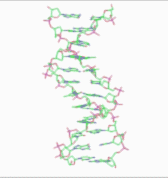
The double helix.
Source: Wikimedia Commons contributors
As soon as they had added the last nitrogenous base, fearful of Pauling, Watson and Crick rushed to the presses with a hastily-drawn single-page paper describing their discovery: the double helical structure of what one blog calls "the most important molecule in human history".[11]
In a much-cited anecdote (that Watson recalls but Crick has no recollection of), on the day they were finished with their model, Crick declared to the patrons at The Eagle pub that they had "found the secret of life."[12] What was it that they had discovered that warranted such a grandiose pronouncement? Here's a few reasons:
By pairing the nitrogenous bases, the model explains Chargaff's rule: A=T and G=C.
It explains mutations, how a single change in a letter can cause macroscale changes.
It explains replication: since A can only pair with T and G with C, you only need one strand to make the other strand. As the pair themselves (the human one) stated in their paper, in the third-to-last sentence, in typical understated fashion: "It has not escaped our notice that the specific pairing we have postulated immediately suggests a possible copying mechanism for the genetic material."
The discovery ushered in "a new biological era"[14], giving rise to molecular biology, and making possible, and spurring, projects like the Human Genome Project, as well as a slew of new ways to uncover and fight diseases.
Curtain close

Source: Wikimedia Commons contributors
I often hear Watson and Crick being described as the discoverers of DNA. That's not true: they are the discoverers of DNA's structure. And if I've done my work well in this post, you'll know by now even that's only partly true, given how much Rosalind Franklin inputted into that discovery.
Franklin was the one who suggested that the phosphates should point out and the bases should point in[9]. Without that insight, Watson and Crick would be laboring under the same erroneous model as Pauling. It was her X-ray images that suggested a double helix structure, and her calculations that allowed Watson and Crick to build an accurate 3D model. It was those same X-rays that gave Franklin ovarian cancer[9], from which she died at age 37, a few years before the Nobel prize was given to Watson and Crick and her colleague Wilkins (Nobel prizes are not awarded posthumously), making Franklin not only the person who contributed the most to the discovery of DNA, but also the one who sacrificed the most. And she could've done it without anyone else, given some time. How much time? Crick's own estimation is that it would've taken Franklin three months to figure out the structure of DNA herself.[9]
Barring Franklin and her input, it's quite possible Pauling would have made the discovery, and would possibly become the only person in history to have won 3 unshared Nobel prizes. Watson and Crick relied too much on gab and the work of others. Chargaff (of "Chargaff rule" fame, if you have the memory of a goldfish!), met the duo, and said of them: "I never met two men who knew so little and aspired to so much"[13]. But their gift of gab got them into places and procured them the necessary information to complete their work, opening doors that competition tried to keep closed.
This brings up another issue that will strike anyone who studies the history of the discovery: several people and institutions acted as hindrances to the open flow of information, but Watson and Crick's tenacity broke through all of them. Without their 007 shenanigans and the willingness of others to share research openly, the discoveries they made would still have been made — only much later. A single case study is not sufficient to make a generalization, but it brings up interesting questions.
Which I will leave unanswered!
Fun Fact
The reason the duo are known as Watson and Crick, instead of the more alphabetically sensible Crick and Watson, is because of the order in which their names appeared in the seminal DNA paper. That order was decided by a coin toss.[12]
References
1. Wikipedia contributors, "Helix Bridge," Wikipedia, The Free Encyclopedia, https://en.wikipedia.org/w/index.php?title=Helix_Bridge&oldid=816344186 (accessed January 17, 2018).
2. OpenStax, Biology. OpenStax CNX. May 27, 2016 http://cnx.org/contents/185cbf87-c72e-48f5-b51e-f14f21b5eabd@10.53 https://cnx.org/contents/GFy_h8cu@10.53:U7tPDRxK@7/DNA-Structure-and-Sequencing
3. Pray, L. (2008) Discovery of DNA structure and function: Watson and Crick. Nature Education 1(1):100 https://www.nature.com/scitable/topicpage/discovery-of-dna-structure-and-function-watson-397
4. OpenStax, Biology. OpenStax CNX. Sep 30, 2015 http://cnx.org/contents/185cbf87-c72e-48f5-b51e-f14f21b5eabd@9.87 https://cnx.org/contents/GFy_h8cu@9.87:yxeAKc4X@8/Nucleic-Acids
5. Wikipedia contributors, "Photo 51," Wikipedia, The Free Encyclopedia, https://en.wikipedia.org/w/index.php?title=Photo_51&oldid=820385123 (accessed January 17, 2018).
6. George Johnson. On DNA’s Anniversary: How Rosalind Franklin Missed the Helix. http://blogs.discovermagazine.com/fire-in-the-mind/2013/04/25/on-dnas-anniversary-how-rosalind-franklin-missed-the-helix/#.Wl-EHTeYOM8
7. The Rosalind Franklin Papers. The DNA Riddle: King's College, London, 1951-1953. https://profiles.nlm.nih.gov/ps/retrieve/Narrative/KR/p-nid/187
8. Matthew Cobb. Sexism in science: did Watson and Crick really steal Rosalind Franklin’s data? https://www.theguardian.com/science/2015/jun/23/sexism-in-science-did-watson-and-crick-really-steal-rosalind-franklins-data
9. Rosalind Franklin's Legacy. http://www.pbs.org/wgbh/nova/tech/rosalind-franklin-legacy.html
10. J. D. WATSON & F. H. C. CRICK. Molecular Structure of Nucleic Acids: A Structure for Deoxyribose Nucleic Acid. Nature 171, 737–738 (25 April 1953). https://www.genome.gov/edkit/pdfs/1953.pdf
11. The Watson and Crick Structure of DNA. https://paulingblog.wordpress.com/2009/04/30/the-watson-and-crick-structure-of-dna/
12. The Francis Crick Papers. The Discovery of the Double Helix, 1951-1953. https://profiles.nlm.nih.gov/SC/Views/Exhibit/narrative/doublehelix.html
13. Bonnie Denmark. The secret of life revealed: Today in science history. https://www.visionlearning.com/blog/2016/04/25/secret-life-revealed-today-science-history/
14. "The Discovery of the Molecular Structure of DNA - The Double Helix". Nobelprize.org. Nobel Media AB 2014. Web. 17 Jan 2018. http://www.nobelprize.org/educational/medicine/dna_double_helix/readmore.html
15. Griffiths AJF, Gelbart WM, Miller JH, et al. Modern Genetic Analysis. New York: W. H. Freeman; 1999. The Nature of DNA. Available from: https://www.ncbi.nlm.nih.gov/books/NBK21261/
Earlier Introduction to Biology episodes:
9: The Great Kitchen Blender Experiments: How DNA was proved to be the seat of heredity
8: Finding, Counting, and Ordering Genes Using Incredibly Sophisticated Biomolecular Megatechnology
7: Christmas Disease — Yes, it's real, 100% scientifically proven!
6: The Most Famous All-Nighter in the History of Genetics
5: Mendel's Lucky Number Seven — The law of genetics that almost wasn't
4: How Cells Use Logic To Do The Impossible
3 : Armchair Science — The Discovery of Proteins' Secondary Structure
2 : How Cell Membranes Form Spontaneously
1 : Eduard Buchner: The Man Who Killed Vitalism
steemSTEM is the go-to place for science on Steemit. Check it out at @steemstem or browse the #steemSTEM tag or chat live at steemit.chat
Glad to see Rosalind Franklin, one of my favorite scientists, getting credit for her input. This story really highlights some of the fascinating drama behind monumental discoveries in biology and genetics. Thanks for making it such a good read!
And thank you for reading!
Much like with Edison, those with shere will-power to disgard social, legal, and ethical conventions tend to rise to the top. The reward model of our Western social matrix dispropotionately values firsts resulting in the gabs outshining the methodical, the patient, and the cautious. Whether such preference engenders the type of environment suited to intellectual discovery, the current devolution of research into the realm of pseudo-science and pseudo-intellectualism illustrates clearly.
Well put.
And, also, ya know, being a man helps.
Wow, a history lesson and science lesson in one! (I was drawn in by the Great GATC-by pun, stayed for the facts.) I think I would have been on Rosalind Franklin's side on jumping to conclusions. Also, thanks for citing your sources!
Me too.
Thanks for reading! )
What a well elaborated article again you gave!
I will read this peace later on in more depth. But I like to mention that you seem to be a supporter of the females involved in the scientific findings and experiments. Or the under dogs. I like that you do that and that you correct what is so far known in that realm.
Thank you!
I support whoever's right!
fair enough.
🙌🏻🙌🏻🙌🏻🙌🏻🙌🏻🙌🏻🙌🏻🙌🏻🙌🏻👏🏻👏🏻👏🏻👏🏻👏🏻👏🏻 its so cool to know about secret unrewarded women in history. Ty so much for your research ❤️❤️❤️ please let me know if you want to join a discord community that supports women
Καταπληκτικό το άρθρο σου.. Είσαι φοβερός...
Merci! )
and now we know the rest of the story.
oddly enough I don't remember much about my high school X-ray Crystallography class.
I suppose it was rather transparent.
:D
Walking this bridge quite a few times and I never know there're characters you mentioned get lit.
Never walked it but that's what wikipedia says: "Pairs of coloured letters c and g, as well as a and t on the bridge which are lit up at night in red and green represent cytosine, guanine, adenine and thymine, the four bases of DNA."
I would rather walk it than know that about it tho!
Hmm.. I've got to watch out for it next time.
This is from a very old post of mine if you want to see some other day pictures:
Oh thanks, that's actually interesting to see!
I can still upvote, I don't lose SP right?
And I can still upvote your comment!
Haha.... i guess comment should OK.
Thanks.
Hi: I'm impressed with your coverage here! It seems to make parts of my blog superfluous :) Since reading this a few days ago I have been otherwise occupied (life goes on outside of steemit 😁) and have waited to comment on your two excellent posts.
Thank you for discussing the slight of Rosalind Franklin and the ignoble behavior of Watson, Crick and Wilkins. It would be out of character for me not point out some discrepancy I believe may exist between your post and the actual record--I do this for Rosalind Franklin and her honor. This discrepancy may be partly due to Watson's bad mouthing of Franklin after her death. I looked up some material, to be certain of my facts, and found this quite extensive coverage of her role in unraveling the puzzle of DNA: Rosalind Franklin and the Double Helix (2003 article in Physics Today).
An extended quote from that article:
It seems Franklin had quite a good grasp of what she had discovered and also that some of her insight helped to steer Watson and Crick (along with Pauling) in the right direction. You do indicate this in your blog.
My understanding of the 'obituary' she penned with Gosling was that it was satiric, a jibe at the underhanded role Wilkins had played in the misappropriation of Photo 51.
As usual, this was a great post. I'm impressed with your mastery of the details...way beyond my ken.
As for your most recent post. Get ready. I'm rested and reading. It is, as always a challenge, and--as I think you intend--a bit of a tease.
Thanks again for your detailed reading and commenting!
The historical aspect of the case I guess needs further study. There are probably biases in how the case is reported by different parties, which makes it all the more difficult. Some facts might be suppressed. If I ever make a new version of this post, I'll be sure to study the history in more detail.
Your blogs are always so good. Top tier here on Steemit, in my opinion. There are always questions that arise in my mind when I read your material...this is natural for me whenever something presents substantial ideas.
Reading up on sexual dimorphism in animals right now--thanks for that :)
Interesting and educational post!
Great breakdown, thanks for the read!
excellent publication. You have a new follower. :)
Thanks @rossanavictora )
Pure knowledge and excellence, αδερφέ! A truly academic piece!
Ευχαριστώ! )
@originalworks
Great educational post :)
Good post bro @alexander.alexis
Thanks for sharing
This was extremely interesting, thank you for sharing with us.